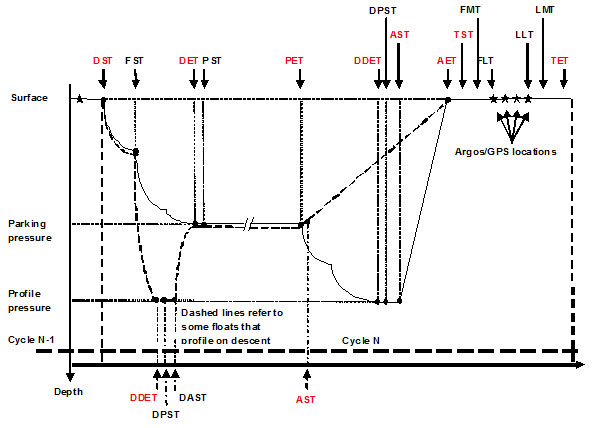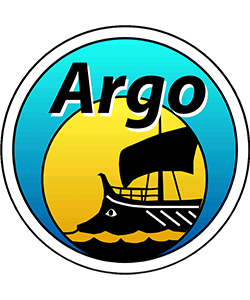 Each Argo float cycle is composed of programmed events. Depending on float type, some of these events can be dated and associated CTD measurements can be provided. The figure to the left shows an example cycle, with the events arranged in the order they will likely occur for Argos satellite communications. For Iridium floats, the order of surface events is different because upon arrival at the surface, the float first obtains a GPS position and then begins communicating with the Iridium satellite system rather than first communicating with the Argos satellite system and then obtaining positions.
Each Argo float cycle is composed of programmed events. Depending on float type, some of these events can be dated and associated CTD measurements can be provided. The figure to the left shows an example cycle, with the events arranged in the order they will likely occur for Argos satellite communications. For Iridium floats, the order of surface events is different because upon arrival at the surface, the float first obtains a GPS position and then begins communicating with the Iridium satellite system rather than first communicating with the Argos satellite system and then obtaining positions.
The figure shows float cycle and the cycle timing variables with primary and mandatory ones in red. Floats can profile either on descent or ascent. Most floats profile on ascent. Their path is shown with a solid black line. Some floats profile on descent as shown by the dashed line.
Floats that profile on ascent would have the following primary & mandatory cycle timings:
- DST, DET, PET, DDET, AST, AET, TST, all surface times and TET
Floats that profile on descent might have the following cycle timings:
- DST, DDET, DAST, DET, PET, AST, AET, TST, all surface times and TET
NOTE: if a float is programmed to experience a primary cycle timing event, but no timing information is sent back and no estimate is possible, fill value should be inserted in the JULD array with the measurement code corresponding to the primary cycle timing event.
Examples of this include:
- SOLO and APEX APF8 floats which send back no cycle timing information should have fill value for the primary measurement codes unless an estimated time can be determined
- Ice detection floats that detect ice at the surface and then do not surface should have fill value for measurement codes 600-704 for the affected cycles.
NOTE: the diagram above shows the chronological order of timing events for an Argos float. Iridium floats have a different chronological order of timing events. In either case, times in the JULD variable should be arranged chronologically.
PDF version of this information is available here.
| Argo cycle timing variables | ||||||||
| Time | Measurement Code (MC) | Long name | N_CYCLE variable name | Description | ||||
| DST | 100 | Descent Start Time | JULD_DESCENT_START | Time when float leaves the surface, beginning descent | ||||
| FST | 150 | First Stabilization Time | JULD_FIRST_STABILIZATION | Time when float first becomes water-neutral | ||||
| DET | 200 | Descent End Time | JULD_DESCENT_END | Time when float first approaches within 3% of the eventual drift pressure. Float may be transitioning from the surface or from a deep profile. This variable is based on pressure only and can be measured or estimated by fall-rate. In the case of a float that overshoots the drift pressure on descent, DET is the time of the overshoot. | ||||
| PST | 250 | Park Start Time | JULD_PARK_START | Time when float transitions to its Park or Drift mission. This variable is based on float logic based on a descent timer (i.e. SOLO), or be based on measurements of pressure (i.e. Provor). | ||||
| PET | 300 | Park End Time | JULD_PARK_END | Time when float exits from its Park or Drift mission. It may next rise to the surface (AST) or sink to profile depth (DDET) | ||||
| DDET | 400 | Deep Descent End Time | JULD_DEEP_DESCENT_END | Time when float first approaches within 3% of the eventual deep drift/profile pressure. This variable is based on pressure only and can be measured or estimated by fall-rate. | ||||
| DPST | 450 | Deep Park Start Time | JULD_DEEP_PARK_START | Time when float transitions to a deep park drift mission. This variable is only defined if the float enters a deep drift phase (i.e. DPST not defined in cases of constant deep pressure due to bottom hits, or buoyancy issues). | ||||
| DAST | 550 | Deep Ascent Start Time | JULD_DEEP_ASCENT_START | Time when float begins its rise to drift pressure. Typical for profile-on-descent floats. | ||||
| AST | 500 | Ascent Start Time | JULD_ASCENT_START | Time when float begins to return to the surface. | ||||
| AET | 600 | Ascent End Time | JULD_ASCENT_END | Time when float reaches the surface. | ||||
| Surface sequence for Iridium floats | ||||||||
| FLT | 703 | First Location Time | JULD_FIRST_LOCATION | Earliest location of all float locations | ||||
| LLT | 703 | Last Location Time | JULD_LAST_LOCATION | Latest location of all float locations. | ||||
| TST | 700 | Transmission Start Time | JULD_TRANSMISSION_START | Time when float begins transmitting. | ||||
| FMT | 702 | First Message Time | JULD_FIRST_MESSAGE | Earliest time of all messages received by telecommunications system. OPTIONAL: many Iridium floats do not send this time |
||||
| LMT | 704 | Last Message Time | JULD_LAST_MESSAGE | Latest time of all messages received by telecommuncations system. OPTIONAL: many Iridium floats do not send this time |
||||
| TET | 800 | Transmission End Time | JULD_TRANSMISSION_END | Time when float stops transmitting. | ||||
| Surface sequence for Argos floats | ||||||||
| TST | 700 | Transmission Start Time | JULD_TRANSMISSION_START | Time when float begins transmitting. | ||||
| FMT | 702 | First Message Time | JULD_FIRST_MESSAGE | Earliest time of all messages received by telecommunications system. | ||||
| FLT | 703 | First Location Time | JULD_FIRST_LOCATION | Earliest location of all float locations | ||||
| LLT | 703 | Last Location Time | JULD_LAST_LOCATION | Latest location of all float locations. | ||||
| LMT | 704 | Last Message Time | JULD_LAST_MESSAGE | Latest time of all messages received by telecommuncations system. | ||||
| TET | 800 | Transmission End Time | JULD_TRANSMISSION_END | Time when float stops transmitting. | ||||
